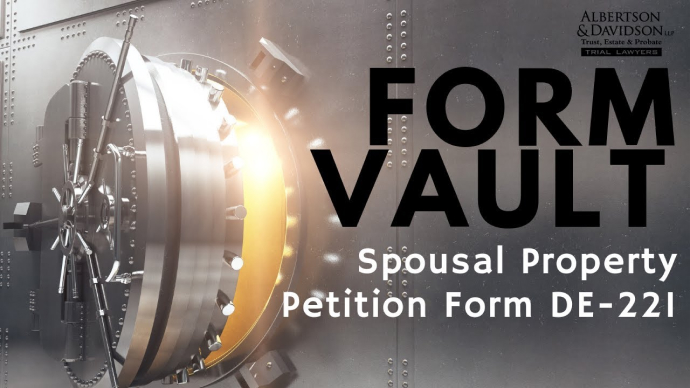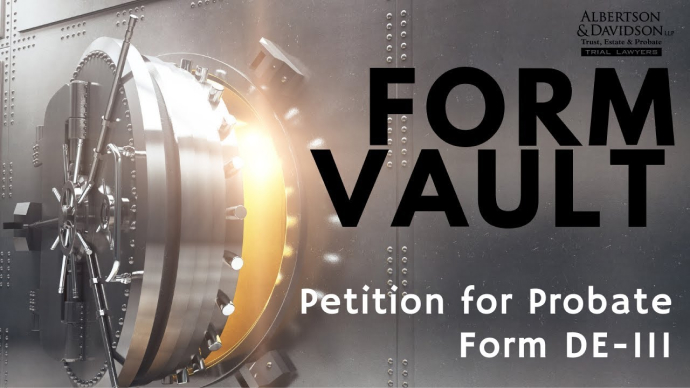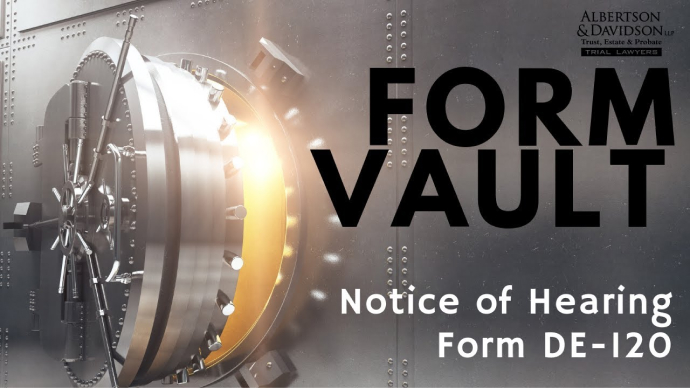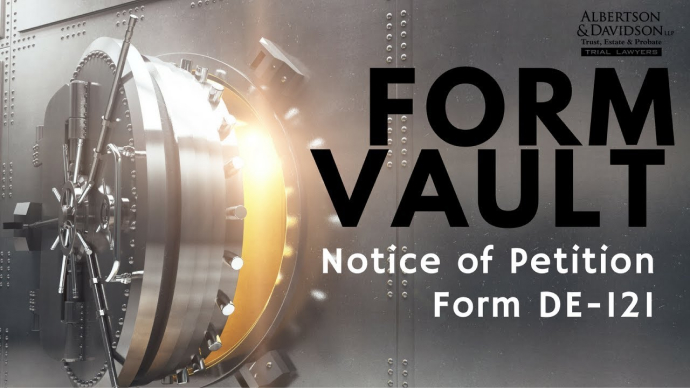Video Transcript
The following is an unedited, verbatim transcript of our video. It is not intended to be a stand-alone article.
Hi, this is Keith Davidson at Albertson & Davidson. In this video, I’m going to be discussing spousal property petitions. Now, this is a very effective tool to use if one spouse passes away and leaves assets to the surviving spouse. Under the probate code, the surviving spouse does not have to go through a full-blown probate administration. And a lot of people don’t know that, people don’t know it, and there’s attorneys who don’t know it. But you do not have to do a full-blown probate to pass assets out from one spouse to another spouse. Instead, you can use a spousal property petition and I’ll walk you through that and show you how it works.
DE-221
So we always start by going to the California Judicial Council site, I just put it into Google, and I find the link for the California Judicial Council. And once we’re on that site, you can go up to forms and rules, you can browse the forms, and we’ll just go down and we’re using the Probate forms – Decedent’s Estates, and there you have it. So, under Decedent’s Estates, we are going to be looking for form number 221, DE-221, which is our California Spousal or Domestic Partner Property Petitions. So in California, we do have registered domestic partners, everything I say about a spouse applies to a registered domestic partner as well, and we’re going to go to that form. So here is the form, and really, there is two different things that you’re going to do with this form, and I’ll show you as we walk through it.
Confirming Property Ownership
Number 1, you’re going to ask the court to confirm what property already belongs to the surviving spouse. So if you have community property in California, 50% of it belongs to the deceased spouse, and 50% percent belongs to the surviving spouse. So this petition is going to ask the court to confirm that the surviving spouse already owns half the property as their share, or the community property. The form’s also going to ask the court to transfer the other half that the decedent owned to the surviving spouse. So we’re going to start up top here, and if you’re representing yourself on this sort of form, you can just put your own name in here, but if you have an attorney, then we’ll go ahead and type the attorney’s name and bar number, and then we’ll put in the name of the law firm, and we’ll put in all the other relevant address information. You also want to make sure that you fill in, obviously your phone numbers so the court can get a hold of you, if you have a fax number, it’s now optional, you can include that. You definitely want to put your email because that is one way that the court can get a hold of you. And you can say who you’re the attorney for, let’s go ahead and use Nancy Smith. So Nancy Smith is going to bring this spousal property petition and it’s going to be for the transfer of community property and her husband’s separate property to her. So, then you can type in the county, whatever county you’re in. And don’t forget to put the street address of the court and also the mailing address, and a lot of courts they are the same, some courts are different, you can look that up on the court’s website. And you can put in the branch name if you know it, and if you don’t, you can look it up on the website, and if you can’t still find it, you can just leave that part blank. So we’re going to do the estate of Bob Smith, and if you don’t have a case number over here, don’t worry about it, the court will assign one when you file this form. The court’s also going to assign you a hearing date. And it will assign the department and the time of the hearing for you, so all of this can be left blank when you fill out this form. And then you have to say whether you’re bringing a spousal or domestic partner property petition, we’ll do spousal, everything I’m about to say applies equally to either group. So again, we’re going to put the petitioner’s name, which is our client Nancy Smith, and we’re going to check the appropriate box. So under 1a, this is for determination of property passing to the surviving spouse without administration. So this all the property that is owned by the deceased spouse that we want to pass as a survivor, so we’re going to check “a”. B is confirmation of property already belonging to the surviving spouse, so the surviving spouse already owns 50% of the community property, we want the court to confirm that, and to confirm the half of it is already owned by our client Nancy Smith, so B is what Nancy owns, A is what Bob Smith owns but we want transferred to Nancy Smith. And then you can also ask for the immediate appointment of the probate referee if you need evaluation. Probate referees are normally assigned in regular probates, but since we’re doing this form, we’re not doing a regular probate, so you can ask for a probate referee to be assigned in order to value the asset if you need that.
Establishing the Petitioner and Residency
And then you have to tell the court who the petitioner is. In our case, the petitioner is the surviving spouse of the decedent, but maybe the surviving spouse has already passed away, in that case, the surviving spouse’s personal representative can bring this petition, or if the surviving spouse is incapacitated, then the spouse’s conservator or guardian can bring it, and then the rest of it is the registered domestic partner, same thing, just a different title. So now we’re going to put when the decedent died. So let’s say our decedent, Bob Smith died on August 1st, 2018. And we have to say where he was a resident of. So Bob Smith was a resident of the California county named above. Now, this is important because you’re supposed to file this form in the same county where you would file a Probate. So even though we’re not doing a Probate, you file this petition in the same county where you would file if you were doing a Probate. So that’s why we have to tell the court, yes he was a resident of the county we’re filing in. If you’re filing in Los Angeles but Bob Smith was a resident of San Diego County, you’re in the wrong county. You need to switch courts, so that’s an important function. Now if Bob Smith was not a resident of California but he left real property in this state, then you’re going to probably click “B”, and B is Bob Smith was a nonresident of California but he left an estate in the county named above, meaning he left real property that’s in that county. So Bob Smith lived in Arizona but he owned a home in Los Angeles County, then you’d file for B and you’d file this petition in Los Angeles County.
Did Decedent Die Testate or Intestate?
And then you need to say whether or not decedent died intestate or testate, and all the court’s asking you there is whether or not Bob had a Will. If he died with a Will, he’s testate, if he died without a Will, he’s intestate. It’s just that simple. So we’ll say Bob Smith had a Will and we’ll check the box for testate, and then we’re going to have to attach copies of the Will to this petition so the court can see it because the court wants to know did Bob Smith leave his share of the community and his separate property to Nancy Smith, because that’s the authority that the court will use to now transfer those assets to Nancy Smith. If Bob Smith’s Will says “I leave all of my property to somebody else, to my children and I leave Nancy nothing,” then this form’s not going to work to transfer that property to Nancy, because Nancy doesn’t have a legal right to that property. So the court wants to know what is Nancy’s legal right to this property and it’s either going to be the Will because that’s where the assets flow from or it’s going to be her rights under the intestate laws if there’s no Will. Keep in mind we’re only talking about property that would otherwise go through the probate process. If you have a Trust and the Trust has whatever provisions and it gives Nancy whatever property it says, you’re never going to use this form, you’re never going to need a probate administration. This is only for those cases where you have a probate administration that you otherwise would do. But we’re not going to do it because Nancy is a surviving spouse. So we told the court that Bob Smith was a resident of California, he died with a Will, and let’s assume that the Will just leaves everything to Nancy, we’ll make it easy.
Now 5a, the court wants to know who else was the decedent survived by because these people are going to have to get notice. We want everybody to know what’s going on here, so you can say no child, or child as follows, natural or adopted, or natural but adopted by a third party, meaning he had a child but that child was put up for adoption and somebody else adopted the child. And then you have to say whether or not decedent is survived by any stepchildren or foster children. Stepchildren or foster children sometimes have the rights of regular children depending on the nature of their relationship, and sometimes they don’t, so you have to say that. And you’ll see later by the way on number 5, you’ll see that we’re going to give notice to everybody that we check the box on in 5, they’re going to have to get notice of this petition because they may want to object to it if they think for some reason Nancy doesn’t have a legal right to the property.
On number 6, you only complete this if there is no issue survived by the decedent, that’s not our case. In our case, we’re going to say that Bob and Nancy had children and that makes it easy.
Explaining Why the Probate of Estate is Unnecessary
Now number 7, this is really the important part of this whole form because this is why, this is where we’re telling the court administration of the estate, meaning Probate of the estate, is not necessary because of the following reasons and you’re going to have to do an attachment, and you’re going to have to describe the facts. So on 7a, we’re saying, on attachment 7a, there’s a legal description of the deceased spouses, so we’re talking about Bob’s property that Nancy wants a court order on, saying that that property passes to Nancy. So on 7a, we need to describe any interest, any property, anything that Bob had that’s going to go to Nancy. On 7b, this is going to be a description of all the property or quasi-community property petitioner requests to be determined as having belonged to her, so 7b is a listing of all of Nancy’s property. And then you want to say this is the property that should belong to Nancy.
Number 8 is a little unique, this is if there is a written agreement between the spouses about a non pro-rata division, so maybe the spouses had agreed before death that rather than splitting all the assets down the middle 50/50, one spouse would get a hundred percent of one house for example and another spouse would get a hundred percent of a different house. Whatever it is, it there’s a written agreement, you need to tell the court that and attach a copy. In most cases, there isn’t unless you have a premarital agreement or post-marital agreement, but if there is, then you need to check that box, we’re going to assume that there’s not here.
On number 9, this is where we have the names of relationships and ages of everybody that we described in box number 5, so all of those children need to get notice. We usually just say that all of these people are listed in an attachment and we’re going to type in here “see attachment.” And the reason we do this is so we can have a separate word document where we list all of the kids and their addresses and we can use it for different forms along the way. If you type it into here, first of all there’s not much room, there’s only three lines. And secondly, you to type it each time. It’s easier just to have it on a separate document and you can maintain it. So you can just hit “see attachment” and attach all the people that you’re going to serve with this document. And then you also have to serve everybody who’s listed as the executor in decedent’s Will and you’re either going to list them below or you can again use an attachment, I would highly recommend you use an attachment just so you can use it again on any other forms that you have and just put “see attachment.” And of course, if there are no executors described in decedent’s Will because they didn’t have a Will, you can just hit “none” over here on this side.
Number 11 is kind of interesting, there was a problem in the past where if the Will, the deceased spouse’s Will, gave all of his property to a Trust but the Trust was held for the sole benefit of the spouse, you couldn’t use this form. So let’s Bob’s Will says I give all my property to a Trust but the Trust is the only beneficiary and the Trust is Nancy. So Nancy isn’t technically a beneficiary under the Will, the Trust is, but for all practical purposes, Nancy is a beneficiary under the Will because it just goes to the Trust and the Trust passes it out to Nancy. So number 11, you can check that box, you can say “yes, that’s the case,” and the court can still grant this petition so that’s an update, a really nice update to the form so that you don’t have to be able to preclude, be precluded from using this form just because there’s a Trust involved.
Filing the Petition
Number 12, we have a petition for probate for administration, the court wants to know whether one has been filed, so it either is being filed with this petition, it already was filed, or it’s not being filed and it’s not going to be filed. This form, this petition to pass property to the spouse can be used even if there is a probate ongoing, because some property may not go to the spouse. So you might have some property passing to the spouse, other property not passing to the spouse, you can still use this form, the spouse still has the right and the right to go in, and ask the court to order their share of the property to pass out to them. And that’s really what number 12 is about is, is there a petition pending or not. And then you’re going to put the number of pages you’ve attached, we have a number of attachments that we’ve discussed. However many pages you have, you just need to tell the court. You know, maybe you have four or five, six pages, it doesn’t matter, just put that number in there and then you’re going to date it and you’re gonna, the attorney will sign on the first line as having prepared this. And then you’ll notice that on the second line, this is what we call a verification, so this is where the clients going to sign, so Nancy Smith is going to sign this part. And you’ll see right here, it says I declare under penalty of perjury under the laws of the State of California that the foregoing is true and correct. And that’s just the court’s way of getting a declaration from Nancy under penalty of perjury that everything that was said in this form and every box that was checked, and every fact stated in an attachment is true. So we don’t want to be in a position where a spouse is saying there’s a Will when there really isn’t and that sort of thing, so now Nancy’s under the penalty of perjury to tell the truth. So that’s the petition that you’re going to file.
Filing the Order
And let’s quickly take a look at the order that comes from this, so the order is found on probate form DE-226. So 221 is the petition, that’s what starts the process, you file that first. The order is what finishes the process, that’s where the court is going to issue an order. And you can see that it’s very similar to the petition in the sense that you’re going to do a spousal property petition, of course you’ll fill out all of the top part just like we did with the petition. Only now you’re going to fill in the date of the hearing, the time, the department and the room number, and so all of that will be filled out after the hearing, either by you or it might be filled out by the court if the court requires you to file this order prior to the hearing which some courts do. And then you’re going to put down here what was found, so decedent died on, and it’s the same information that we had in the petition, and they were a resident of California, and they were testate, and they have a surviving spouse, and the name of the surviving spouse is Nancy Smith, and so it’s just recapping all of the important facts.
And then we’re going to come down here to 5a, 5a is the property, a description of the property that’s passing to the surviving spouse.
And then in number 6, this is where the spouse may be required to file what we call an undertaking, it’s kind of like a bond, if there’s any known creditors of the estates. So creditors definitely have to be paid, creditors of the decedent. And the creditors have a right to go against the decedent’s property, well that property is now passing to Nancy, so Nancy is liable for that debt to the extent she received property from Bob’s estate. And number 6 is just where the court may require her to post a bond in order to make sure that those creditors are paid.
And then number 7, this is where the spousal, this is where we actually have the order, so 7a is the property described in Attachment A is property that belongs to the surviving spouse, so 7a is confirming all of Nancy’s property, what she already owns.
And then under number 8, all property described in the petition that is not determined to be property that passes to Nancy in our example or confirmed as belonging to Nancy shall be subject to administration in the estate of the decedent. So all number 8 means is that to the extent there’s something that Nancy doesn’t receive or doesn’t already own, that property does have to go through probate, and if there’s known property, if you know of something then you have to check this box and fill out an attachment.
Submitting to the Court
And number 9 is just a point where you can put any other orders that court wishes to issue, and there you’d put the number of pages attached because there’s a number of attachments here, and once you do that, you can submit that to the court, the judge can sign it and once the judge signs it, then you have a completed spousal property petition and now the spouse can receive the property of the decedent without having to go to a full-blown probate process. So that’s the California spousal property petition and the spousal property order.




